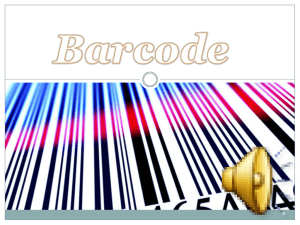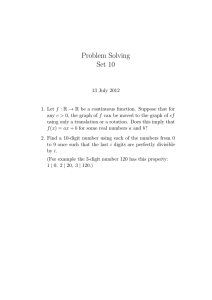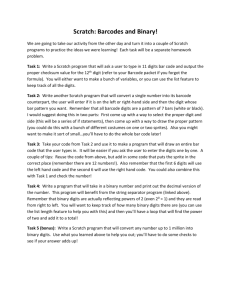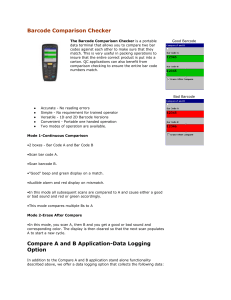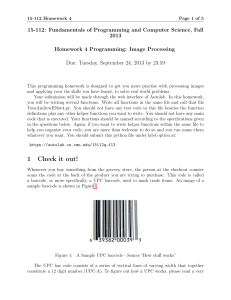MATH NEWS R USNA dt
advertisement
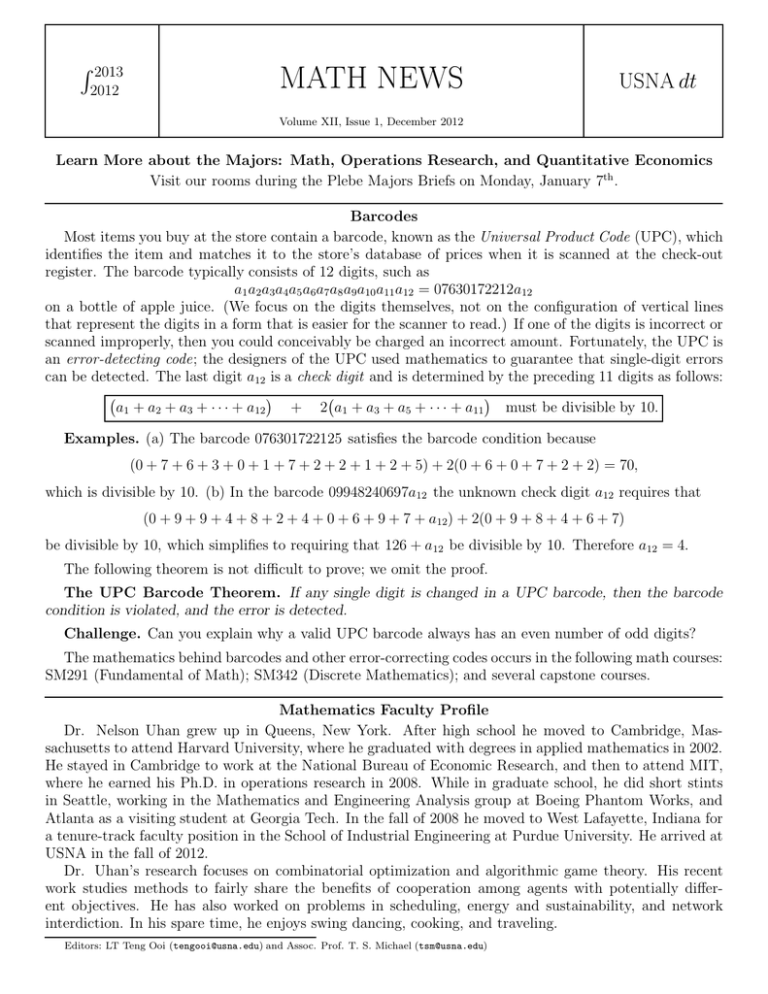
R 2013 2012 MATH NEWS USNA dt Volume XII, Issue 1, December 2012 Learn More about the Majors: Math, Operations Research, and Quantitative Economics Visit our rooms during the Plebe Majors Briefs on Monday, January 7th . Barcodes Most items you buy at the store contain a barcode, known as the Universal Product Code (UPC), which identifies the item and matches it to the store’s database of prices when it is scanned at the check-out register. The barcode typically consists of 12 digits, such as a1 a2a3a4a5 a6a7a8 a9a10a11a12 = 07630172212a12 on a bottle of apple juice. (We focus on the digits themselves, not on the configuration of vertical lines that represent the digits in a form that is easier for the scanner to read.) If one of the digits is incorrect or scanned improperly, then you could conceivably be charged an incorrect amount. Fortunately, the UPC is an error-detecting code; the designers of the UPC used mathematics to guarantee that single-digit errors can be detected. The last digit a12 is a check digit and is determined by the preceding 11 digits as follows: a1 + a2 + a3 + · · · + a12 + 2 a1 + a3 + a5 + · · · + a11 must be divisible by 10. Examples. (a) The barcode 076301722125 satisfies the barcode condition because (0 + 7 + 6 + 3 + 0 + 1 + 7 + 2 + 2 + 1 + 2 + 5) + 2(0 + 6 + 0 + 7 + 2 + 2) = 70, which is divisible by 10. (b) In the barcode 09948240697a12 the unknown check digit a12 requires that (0 + 9 + 9 + 4 + 8 + 2 + 4 + 0 + 6 + 9 + 7 + a12) + 2(0 + 9 + 8 + 4 + 6 + 7) be divisible by 10, which simplifies to requiring that 126 + a12 be divisible by 10. Therefore a12 = 4. The following theorem is not difficult to prove; we omit the proof. The UPC Barcode Theorem. If any single digit is changed in a UPC barcode, then the barcode condition is violated, and the error is detected. Challenge. Can you explain why a valid UPC barcode always has an even number of odd digits? The mathematics behind barcodes and other error-correcting codes occurs in the following math courses: SM291 (Fundamental of Math); SM342 (Discrete Mathematics); and several capstone courses. Mathematics Faculty Profile Dr. Nelson Uhan grew up in Queens, New York. After high school he moved to Cambridge, Massachusetts to attend Harvard University, where he graduated with degrees in applied mathematics in 2002. He stayed in Cambridge to work at the National Bureau of Economic Research, and then to attend MIT, where he earned his Ph.D. in operations research in 2008. While in graduate school, he did short stints in Seattle, working in the Mathematics and Engineering Analysis group at Boeing Phantom Works, and Atlanta as a visiting student at Georgia Tech. In the fall of 2008 he moved to West Lafayette, Indiana for a tenure-track faculty position in the School of Industrial Engineering at Purdue University. He arrived at USNA in the fall of 2012. Dr. Uhan’s research focuses on combinatorial optimization and algorithmic game theory. His recent work studies methods to fairly share the benefits of cooperation among agents with potentially different objectives. He has also worked on problems in scheduling, energy and sustainability, and network interdiction. In his spare time, he enjoys swing dancing, cooking, and traveling. Editors: LT Teng Ooi (tengooi@usna.edu) and Assoc. Prof. T. S. Michael (tsm@usna.edu)
